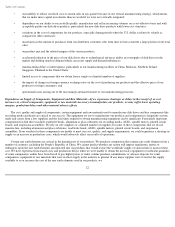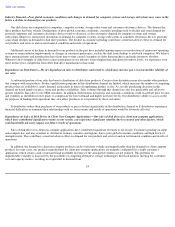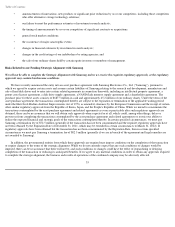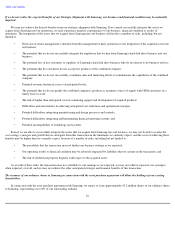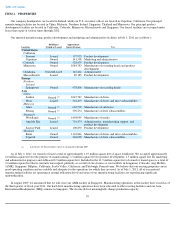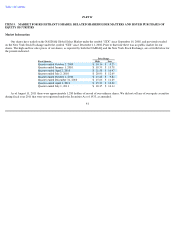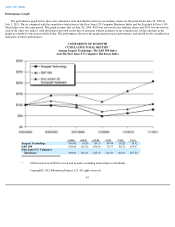Seagate 2010 Annual Report Download - page 35
Download and view the complete annual report
Please find page 35 of the 2010 Seagate annual report below. You can navigate through the pages in the report by either clicking on the pages listed below, or by using the keyword search tool below to find specific information within the annual report.
Table of Contents
currencies. As a consequence, the increased strength of local currencies against the U.S. dollar in countries where we have foreign
operations would result in higher effective operating costs and, potentially, reduced earnings. From time to time, fluctuations in
foreign exchange rates have negatively affected our operations and profitability and there can be no assurance that these
fluctuations will not adversely affect our operations and profitability in the future.
•
Longer Payment Cycles.
Our customers outside of the United States are often allowed longer time periods for payment than our
U.S. customers. This increases the risk of nonpayment due to the possibility that the financial condition of particular customers
may worsen during the course of the payment period.
•
Seasonality.
Seasonal reductions in the business activities of our customers during the summer months, particularly in Europe,
typically result in lower earnings during those periods.
• Tariffs, Duties, Limitations on Trade and Price Controls. Our international operations are affected by limitations on imports,
currency exchange control regulations, transfer pricing regulations, price controls and other restraints on trade. In addition, the
governments of many countries, including China, Malaysia, Northern Ireland, Singapore and Thailand, in which we have
significant operating assets, have exercised and continue to exercise significant influence over many aspects of their domestic
economies and international trade.
•
Potential Adverse Tax Consequences.
Our international operations create a risk of potential adverse tax consequences, including
imposition of withholding or other taxes on payments by subsidiaries.
•
Increased Costs.
The shipping and transportation costs associated with our international operations are typically higher than
those associated with our U.S. operations, resulting in decreased operating margins in some foreign countries.
• Credit and Access to Capital Risks. Our international customers could have reduced access to working capital due to higher
interest rates, reduced bank lending resulting from contractions in the money supply or the deterioration in the customer's or its
bank's financial condition, or the inability to access other financing.
• Global Health Outbreaks. The occurrence of a pandemic disease may adversely impact our operations, and some of our key
customers. Such diseases could also potentially disrupt the timeliness and reliability of the distribution network we rely on.
Political Risks Associated with International Operations
—Our international operations subject us to risks related to political unrest and
terrorism.
We have manufacturing facilities in parts of the world that periodically experience political unrest. This could disrupt our ability to
manufacture important components as well as cause interruptions and/or delays in our ability to ship components to other locations for continued
manufacture and assembly. Any such delays or interruptions could result in delays in our ability to fill orders and have an adverse effect on our
results of operations and financial condition. U.S. and international responses to the ongoing hostilities in various regions and the risk of terrorist
attacks or hostilities elsewhere in the world could exacerbate these risks.
Legal and Operational Risks Associated with International Operations
—Our international operations subject us to risks related to staffing
and management, legal and regulatory requirements and the protection of intellectual property.
Operating outside of the United States creates difficulties associated with staffing and managing our international manufacturing facilities,
complying with local legal and regulatory requirements and protecting our intellectual property. We cannot assure you that we will continue to
be found to be
32


